 By Pepper Parr By Pepper Parr
April 27th, 2021
BURLINGTON, ON
OPINION
The Science Table released their recommendations to Doug Ford and his Cabinet on Wednesday of last week and made them public on Thursday of last week.
Most people fully expected the Cabinet decisions would fairly reflect the recommendations.
 They didn’t. They didn’t.
That was the moment when everything just flipped. Police forces across the province said they would not follow the provincial directions that would permit them to stop people and ask where they were going .
Municipalities across the province said they could not see how they could close the public parks.
Several very prominent people on the Science Table were prepared to resign.
Burlington’s Mayor called an Emergency Council meeting for the Saturday.
The Premier reversed his position on a number of items on the Monday but by then the damage was done.
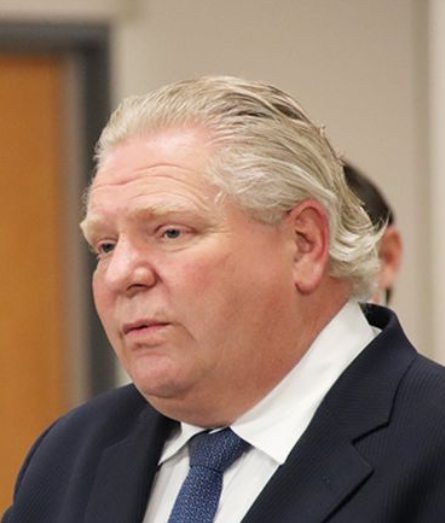 A weary, tired Premier – battered by media, pummeled by public opinion. During a brutal media event that followed, CTV News reporter Colin D’Mello said to Ford: “… you say the buck stops with you, but I think people across this province are wondering, what does that actually mean? Columnists have recently said there is no effective leadership at Queens Park. Another one said you are showing raging ineptitude, and some are calling for your resignation.” D’Mello then asked: “Premier, do you still have the moral authority to lead this province as Premier?
The penny had just dropped. The public has not seen the Premier since.
John Doyle in his Globe and Mail column on entertainment was just as brutal. On Monday of this week he said: “If you live in Ontario, Premier Doug Ford has been ubiquitous on TV for more than a year. Almost every weekday – rarely on weekends – he’s been part of the local newscasts.
“During this pandemic period, his TV appearances and news conferences have had a strange trajectory. It’s been an up-and-down, zigzagging media strategy that was always going to lead to his recent blubbering, blustering mea culpa-filled news conference from a backyard in northwestern Toronto.
“Ford is not a natural on TV. But, watching him, you suspect he thinks he is. His natural mode is combative, dismissive and inflexible. And that has led him and his handlers down a disastrous road. Only media strategists who are themselves right-wing populists with a pro-business, anti-union agenda could possibly think it was ever going to work long-term through a human catastrophe.
“There was a time, at the start of all this, when Ford’s angry inflexibility fit the occasion. Then it didn’t, mainly because Ford and his communications team ceased to focus on the broad public good and began spinning a narrow political agenda that confounded the public and was aimed at a political base only. Inflexible became insincere and then deceitful.”
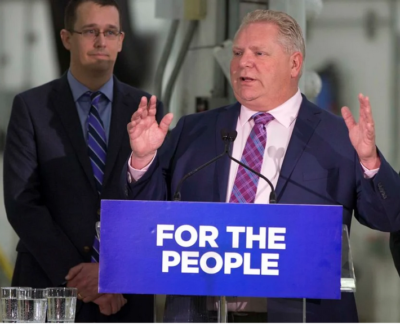 In his first year he couldn’t be stopped – he was everything to everyone. Then the penny dropped March of last year Ford was on TV, enraged by price-gouging when a high-end grocery chain began selling hand wipes, usually costing about $8.49, for $30. “Nothing gets me more furious than someone taking advantage and price-gouging the public that are in desperate need of these items,” Ford thundered. He announced he would enact legislation to outlaw the gouging. The grocery chain backed off and apologized.
Ford’s media strategy went awry precisely when he began to ignore medical experts – that’s an example of media-savvy strength vaporizing – and made explicitly political and ideological decisions.
We’ve seen many things in Ontario this past year and among the most bizarre has been the unraveling of a communications plan that, as soon as Ford’s angry inflexibility became a liability, was always going to end in tears.
And so where are we now? The news Monday reporting the death of a 13 year old girl who died at home of a Covid19 infection while her Mother was in the hospital recovering from a Covid19 infection.
The child’s father, the family breadwinner, had to work if the family was to be fed.
The public fully expected the Premier to announce something that reflected the Science Table recommendations. Sick days pay was front and centre along with target vaccinations programs aimed the “hot spots”.
On Friday of last week – nothing
Saturday, Sunday nothing. Premier Ford does not work weekends.
Surely there would be something on Monday.
Nothing.
 Editorial cartoonists had found there mark – they were merciless. While the provincial leadership appeared to be frozen, Medical Officers of Health in Brampton and Toronto were inspecting work places where there were large numbers of employees working in crowed conditions. The different Medical Officers of Health shut plants down for for periods of time.
Not a word from the Chief Medical Officer of Heath for the province reporting on what was happening.
Each day the number of new infections and deaths were reported – positivity rates were above the 10% level.
There had been no action on the desperate need for paying people who should not be reporting for work.
Yesterday and today the public learns that the federal government and the provincial government were bickering over a plan that would put $1000 a week into the pockets of those who had to stay home from work.
The sticking point was who would run the program. The federal government has their CERB program – all a person had to do was apply and then wait for the money to appear in their bank account.. The federal program was limited to $500 a week – Ontario said they would top it up to $1000 if the federal government ran it. The federal government said the computer application wasn’t flexible enough to be revised.
What the public was seeing was the equivalent of a bunch of chickens running around with their heads chopped off – blood all over the place.
Factory and assembly line workers in the Brampton area were, in the words of one scientist, “being left to burn”.
The province was reported to be anxious about how their stakeholders would react to being forced to pay people who did not report for work because they were ill.
Meanwhile Amazon, Sobeys, Loblaws and others were reporting massive revenue gains.
There is a simple solution – have the province order the corporations to pay people if they are not well enough to work and then let the corporations turn to the federal and provincial governments for reimbursement.
Those companies have payroll procedures in place – they can move money into bank accounts in literally minutes.
All we have to do is coax the Premier out of hiding and do another media event where he tells his Minister of Finance and Minister of Labour to get into a conference room (wear your masks – keep six feet apart) and figure this out and have a solution they could take to Cabinet.
The provincial bureaucracy would arrange for pizza and some of that buck a beer to sustain them while they figure it out
We are facing a disaster – we know what has to be done – other jurisdictions have solved this problem.
Ontario, the economic engine of the country, is now relying on medical people from the Maritime provinces and the armed forces to fly in and help us through this. The last time that happened was when Mel Lastman called in the army to clear snow from the streets.
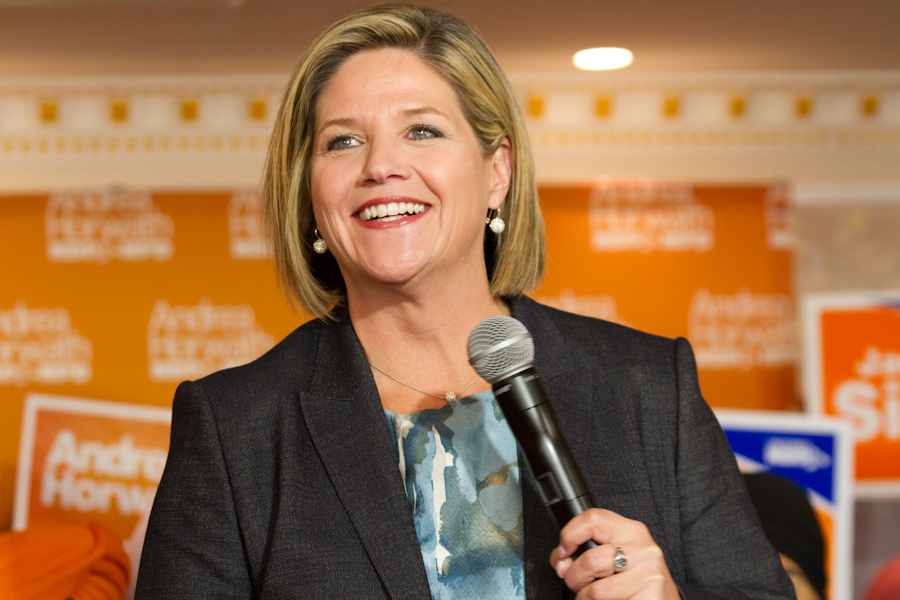 Could Andrea form a government? Doug Ford has has shown that he is not up to the job that has to be done. There isn’t all that much in the way of leadership on the opposition benches to replace the current government and one can’t see any of the Cabinet members itching to be Premier.
Later this week there will be a funeral for a 13 year old girl who died despite her father using CPR to get oxygen into her young lungs.
Nothing in the way of condolences from the Office of the Premier.
These tragedies have to stop.
Salt with Pepper is the musings, reflections and opinions of the publisher of the Burlington Gazette, an online newspaper that was formed in 2010 and is a member of the National Newsmedia Council.

 By Mike Nixon, By Mike Nixon,
April 26th, 2021
BURLINGTON, ON
I have always been a very avid reader of anything of an historical nature. After all, it seems that the best, and sometimes most unbelievable stories find their basis in truth. And of such great importance especially now, I firmly believe that there is truth in Maya Angelou’s statement that, “You can’t really know where you are going until you know where you have been.”
 The Airborne Activist, Amelia Earhart on the cover of Canada’s History magazine – why did that happen. It probably isn’t so surprising then to learn that I recently read through an issue of Canada’s History magazine which captured my eye with a photo of Amelia Earhart on the cover. I have tremendous admiration for the many accomplishments of Ms. Earhart – her story is quite amazing! But my immediate thought upon seeing her picture on the cover of a Canadian history publication was, “what on earth was Amelia Earhart’s connection to Canada?” The answer was remarkable and is a beautiful story which ties into this month’s National Volunteer Week in Canada!
The story goes that in the latter part of WWI, Amelia visited her sister (who was enrolled at St. Margaret’s College in Toronto) during Christmas, 1917. While walking along King Street one day with her sister they came upon four soldiers, each missing a leg and supporting each other. This so shook Amelia that she had to duck into a local store – perhaps not a surprise given that the U.S. had only that year entered the war, and the ravages of battle were not so much a common sight there.
Instead of returning to the U.S., Amelia decided to stay in Toronto so she could help in the war effort. She completed courses in first aid and home nursing at the St. John’s Ambulance Brigade becoming the sole American to enroll in wartime for the Volunteer Aid Detachment. Dubbed “Sister Amelia” by those she tended to, Earhart spent several years here volunteering her time in everything from working 12-hour days emptying bedpans, making beds, washing patients and serving food to preparing laboratory slides and cultures.
This is a singular example of volunteerism at the time, but not by any means remote. Volunteering is a way of life for many Canadians – it is now and has been since confederation. Some volunteers and volunteer organizations have been inspired – like Earhart – by compassion, some by injustice, others by the simple want to help and support their neighbours and communities.
This Canadian tradition of helping fellow citizens in many ways started on the concept of ‘loving our neighbours,’ building on the values of our Native communities, Canada’s first Christian settlers and the members of virtually every religion which have arrived in Canada since.
And it’s fascinating to know that the roots of many of our volunteer efforts now have a direct relationship to the traditions of our multicultural heritage, from practices adopted in the Maritimes from the English Poor Laws of the 18th century, to Canadians of German descent forming the first funeral or burial society in Halifax in 1753, the founding and work of the Chinese Consolidated
Benefit Association in the late 1800’s, to the founding of the CNIB as a direct effect of the 1917
Halifax explosion.
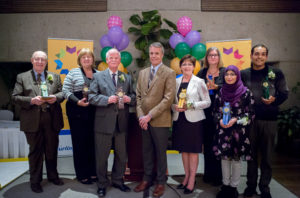 Burlington’s Best was one of the way the city recognized those who went above and beyond in serving their community. Mayor Meed Ward made the wise decision to reorganize the way the city recognized people – then Covid19 hit and the event was halted. The expectation is that it will be revived. Fast-forward to present day, volunteerism in Canada connects people, communities, non-profit and public organizations and, quite frankly all that we do now like at no other time. In 2018 almost 13 million people volunteered for charities, non-profits and community organizations in Canada, accounting for approximately 41% of Canadians aged 15 and over. They dedicated about 1.7 billion hours to their formal volunteer activities (people giving unpaid help through groups, clubs, and organizations) – a volume of work equivalent to more than 863,000 full-time year-round jobs.
Perhaps not surprisingly Baby Boomers and Matures (ages ranging from 56 – 103) were over 70% more likely to iGens (born 1996 and up) to be ‘top’ volunteers, spending 132 hours more on volunteer activities.
But hold on …. and perhaps a silver lining of the current pandemic – with many baby boomers and matures now struggling to keep their businesses afloat or working from home, concerned about their own health and isolating, and in some cases caring for elderly parents, this group has had less time for volunteering during the pandemic. During this time there has been a remarkable surge of iGens, Millennials, and Gen Xers who have been committing to informal volunteering – volunteers providing unpaid help as an individual to others (non-relative) through activities such as shoveling snow, shopping for the elderly and many other examples.
In our own backyard – in the Region of Halton it is estimated that approximately 200,000 volunteers (age 15 and over) put in over 325,000 hours per year. If we apply an average wage of $27 (76% of the economy wide average wage of $35.50/hr), this equates to approximately $870,000,000 + or 17,000 full-time jobs – or 11% of all full-time jobs in Halton.
Last week was National Volunteer Week in Canada. And of course, as part of Community Development Halton, Volunteer Halton has been very actively involved. We would have liked to have hosted our annual (in-person) Volunteer Recognition Breakfast – which obviously we couldn’t. That wasn’t going to stop us, however from focusing on the most important aspect of that event – the amazing volunteers in this Region who give of their time, helping our neighbours and make living in Halton so fulfilling.
Through interaction with many of our community groups in the four major centres in Halton we were able to identify 8 individuals who CDH and Volunteer Halton were proud, and quite frankly privileged to present our 2021 Volunteer Impact Awards. In all honesty, every single volunteer whose names were put forward – and those who were not – deserved awards as well! Every ounce of commitment put into individual acts of volunteerism within our communities was so well appreciated by the community groups through whom the volunteers participated and especially by those for whom they served.
I personally had the immense joy of being on hand for each of these presentations. It is so easy to get down during this pandemic, but I must say that each of the days in which my colleague, Heather Thompson and I had the pleasure of meeting these volunteers and the organizations who nominated them, was pure joy for me. To see the passion which drives these individuals, the commitment they have provided – many of them for years and for several organizations – and to
experience ‘vicariously’ through the volunteers the fulfillment which they receive by giving of themselves, well, it was so gratifying for me and filled me with immense pride. Not only to meet these incredible individuals and families but to feel even just a little part of the amazing compassion that they provide to their ‘neighbours.’
I can’t say strongly enough how important these volunteer efforts are to the communities in which we are all most fortunate to live. Our volunteers make lives and living better for us all and I can only suggest that more of us get involved with the wonderful missions which each of Halton’s community groups operate throughout the year – you will be overwhelmed at how good it feels.
I invite you to please take a look at the beautiful stories of those to whom Volunteer Halton had the privilege to present awards. You can read these stories on CDH’s website or through this link https://cdhalton.ca/2021/04/23/halton-volunteer-impact-award-2021.
How important is it to one who gives so much of themselves through their volunteer work? I can answer quite simply by quoting one of the lovely individuals with whom I had the pleasure of meeting last week …. “volunteering is as necessary to me as breathing.”
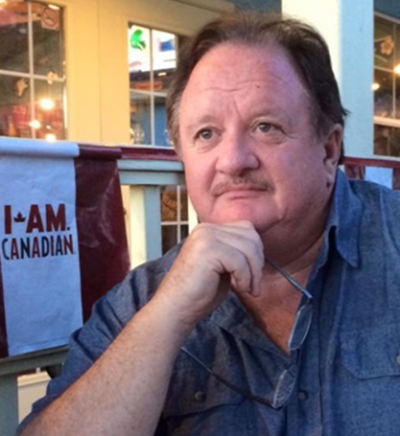 Mike Nixon is the Executive Director of Community Development Halton. Mike Nixon is the Executive Director of Community Development Halton.

 By Pepper Parr By Pepper Parr
April 24th, 2021
BURLINGTON, ON
The week was a media bonanza for ward 2 Councillor Lisa Kearns.
 Ward 2 Councillor Lisa Kearns On Wednesday she handled a two hour webcast on what is known now as Fairview LP, the gigantic development that will rise on the 8.5 acre property to the east of the Burlington GO station; on Thursday she held a ward meeting in which she jammed in everything she could possibly tell you about what she is achieving at city hall.
There was one item of significant interest in the city hall recap – that was what appears to be a new and very welcome approach to creating budgets.
Kearns first explained that the 4.14% increase on the city portion of your tax bill was really necessary – that can be argued at some future date.
Kearns also explained how hard council had worked to get a budget in place before the end of March.
The Finance department prefers to get a budget in place before the end of a calendar year but Covid19 has screwed up everything everyone is trying to get done.
 The practice in the past was to invite the public to “review” the budget that had already been decided upon. It was community engagement at its worst – getting public input before city departments did their work would be classic community engagement. The plan, if we heard to ward Councillor correctly, was to start budget thinking in June and ask the public what they would like to see before having the various departments submit their first cut on a budget.
The Gazette has been advocating this for years – maybe, just maybe, they will ask the public how they would like to see their money spent.
Done properly this could be very effective.
Time will tell.
Salt with Pepper is the musings, reflections and opinions of the publisher of the Burlington Gazette, an online newspaper that was formed in 2010 and is a member of the National Newsmedia Council.

 By Ray Rivers By Ray Rivers
April 22, 2021
BURLINGTON, ON
Just like that it was over! Presentation of a budget with no real surprises, unlike the almost alarmist complaining by the opposition parties that it had been two years in coming. And it’s a huge budget document with spending to match. There was relatively little post-budget fuss except for the habitual Tory complaints about the mounting size of the deficit and the debt.
 Minister of Finance and Deputy Prime Minister Chrystia Freeland preparing to speak to her budget which Prime Minister Justin Trudeau leafs through. None of the opposition leaders want an election right now, so they are behaving very gingerly to avoid an excuse for an election. The polls show the Liberals would win again and maybe with a majority this time. And the Libs would love to take advantage of that, but we’re in probably the worst phase of the pandemic now and the voters resent it when opportunistic governments call inconvenient and untimely elections. So it’ll come but not just yet.
The pundits are calling this an election budget anyway. And it is loaded with goodies for just about everyone. A chicken in everyone’s pot. In any case it’s all borrowed money – so more like the government borrowing your chicken to give it back to you. The biggest goodies are climate related initiatives, creating a million jobs this year, and a ten dollar a day national child care program. But everyone gets some kind of handout, be it farmers, householders, green energy start ups, existing oil companies, and even seniors.
The $10 a day pre-school plan is long overdue for a society which values social interdependence as Canadians like to think we do. Quebec’s successful program is the template which the feds are looking at. The results from la Belle Province include better early education, increased female participation in the labour force and economic growth.
We too might have already had this program. But Jack Layton’s NDP’s pulled the plug on Paul Martin’s minority government in 2006 and with it died a unique federal provincial agreement to establish a national child care program. Stephen Harper’s, supported by Layton, killed the initiative and gave parents some cash instead, which as one Liberal partisan noted, would likely buy beer and chips instead. So Mr. Singh is on shaky ground when he claims this has been a long term NDP policy.
 Federal civil servant handing over a cheque to a Quebec civil servant. Having showed their hand Mr Trudeau and his finance minister have got their job cut out for them getting the current field of cash strapped premiers to ante up and sign on to a new plan. And the feds have weakened their negotiating position by saying they would be picking up half of the bill. Quebec has signaled that it would be happy to get a cheque instead, since it already has a program.
Not every good idea made it to the budget however. Rank and file Liberals who paid their money to participate in the recent policy convention must be disappointed that their highest priorities seem to have got lost. Pharmacare, a priority also for the NDP, seems to have been overlooked, though another NDP policy, a federal minimum wage of $15 per hour, has been included.
Universal basic income (UBI) didn’t even get a mention though about 90% of voting delegates supported it at their convention. That is probably because a UBI would make it more difficult to justify the kind of piecemeal pork that get handed out with this kind of budget – discretionary top-ups and the continuation of COVID emergency programs, most of which are poorly thought out, like the problematic federal sick leave.
And then there is the mother of all wasteful programs – the COVID wage subsidy. At about $100 billion the wage subsidy is the most costly federal COVID-19 program, and one of the most expensive short-term government programs in Canadian history. Companies get taxpayer money so they can keep people on the payroll when they don’t have enough work for them. Isn’t that what we used to call Soviet-style socialism?
 Canadian Football League wants to get its snout into the trough as well But it turns out that is a great way to put more money into the pockets of shareholders and to fatten the bonuses and salaries of senior executives, while regular workers are given the boot anyway. Apparently even the big three telecoms are sucking up wage subsidy money, even at a time when internet usage is up 70-90%. And telecom rates haven’t declined that I’ve noticed, so how do they qualify? And how does the CFL (Canadian Football League) get to dip its pigskin in the trough as well?
Who would approve such a wasteful program? Turns out it was a unanimous decision of all the patties. And, this has to be a conflict of interest because all four national political parties have also applied for a wage subsidy from this program. So the next time Erin O’Toole complains about the mounting cost of the deficit, someone should remind him that he and his party are also a big part of the problem.
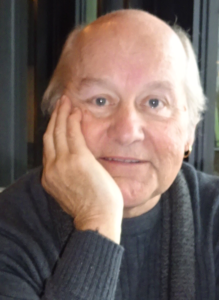 Ray Rivers, born in Ontario earned an economics degree at the University of Western Ontario and a Master’s degree in economics at the University of Ottawa. His 25 year stint with the federal government included time with Environment, Fisheries and Oceans, Agriculture and the Post office. Rivers is active in his community; has run for municipal and provincial office. Ray Rivers, born in Ontario earned an economics degree at the University of Western Ontario and a Master’s degree in economics at the University of Ottawa. His 25 year stint with the federal government included time with Environment, Fisheries and Oceans, Agriculture and the Post office. Rivers is active in his community; has run for municipal and provincial office.
Background links:
Budget – Wage Subsidy – Political Parties at the Trough –
Cost of Wage Subsidy – The Rip Off Crowd – Sealing the Deal –

 By Sarah Miller Liana By Sarah Miller Liana
April 21st, 2021
BURLINGTON, ON
Reprinted from the Christian Science Monitor
The headline read:
‘Humbling’: Canada’s self-image slides in pandemic as US rebounds
Last year, as the first wave of the pandemic waned, Canadians were grieving from the toll of it all. Yet they were also relatively grateful – especially as they looked at their neighbor to the south.
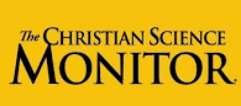 The pandemic amplified all the things Canada lauds itself for when it compares itself with the United States – as a nation that is a fraction of the size of the powerhouse next door often does. Its universal health care, a functional government, a communal spirit, and a rule-abiding culture were held up as reasons that case numbers stayed reasonably low. The U.S., meanwhile, bickered about masks and whether the virus was a hoax as cases surpassed anywhere else in the world. The pandemic amplified all the things Canada lauds itself for when it compares itself with the United States – as a nation that is a fraction of the size of the powerhouse next door often does. Its universal health care, a functional government, a communal spirit, and a rule-abiding culture were held up as reasons that case numbers stayed reasonably low. The U.S., meanwhile, bickered about masks and whether the virus was a hoax as cases surpassed anywhere else in the world.
Now Canada finds itself amid a daunting third wave. And as the U.S. has flexed its muscle in an ambitious inoculation campaign, a counter-narrative is emerging among some Canadians that finds them unsettled but also humbled. It underscores a national inclination toward comparative assessment that can often blind the country to its own shortcomings on everything from gun violence to racism to health care – and make it too hard on both the U.S. and itself.
For months, Canada looked at the U.S. pandemic response and felt a sense of superiority. But now the narrative has flipped, and it’s pointing to the danger of building a sense of self-worth on comparisons.
“A year ago it was all about how America breaks the rules … while we are a ‘play by rules crowd,’” says Michael Adams, the president of the Environics Institute, which measures Canadian attitudes. Now the narrative centers around just how much of a global leader in science, manufacturing, and distribution the U.S. is while Canada waits.
“You need a balanced view,” he says. “We – the world and Canada at the head of the list – are benefiting from American innovation and an American can-do philosophy. You can’t just look at America through all the problems they have.”
For the first time, as the world enters year two of the pandemic, Canada has surpassed the U.S. on a per capita basis for the number of new COVID-19 cases, shaking its sense that its compliant culture or commitment to public health would protect it from the worst playing out south of the border.
Today, while many Americans start traveling and tasting a return to normalcy, many parts of Canada have entered their darkest moment. British Columbia has issued a “circuit breaker” shutdown. Quebec extended a months long curfew, ordering residents home by 8 p.m. in some cities like Montreal, leading to protests there.
Ontario, where 40% of Canadians live, has been hardest hit. This week it announced it was shuttering schools indefinitely. Hospitals have canceled all but emergency surgeries for the first time since March 2020 and are preparing field hospitals as record cases wallop the province.
Meanwhile, the U.S. has been far faster at providing shots to those who want them, with 38% of Americans receiving one dose versus 22% of Canadians. Canada is dependent on global supply chains for its doses, and is hoping to get more surplus from the U.S. All this feeds directly into Canadian perceptions of how they stand next to the U.S.
Aisles of non-essential goods are cordoned off at a Walmart store, as new measures are imposed on big-box stores due to the pandemic, in Toronto, April 8, 2021.
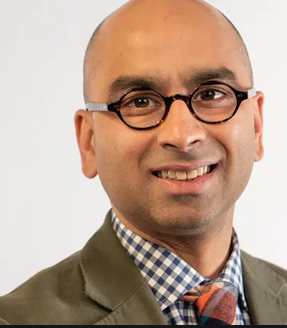 Randy Boyagoda: professor of English at the University of Toronto “Canadians define themselves against the United States, and did so perhaps with greater satisfaction and justification over the past four years, and in particular during the dramatic playing out of the pandemic over the past year,” says Randy Boyagoda, a Canadian novelist and professor of English at the University of Toronto. “Now Canadians are forced to reconsider one of the fundamental features of their self-understanding.”
The founding idea of Canada lies in “peace, order, and good government.” Dr. Boyagoda saw proof of that reiterated in the orderly, yet slower, vaccine rollout where he is in Ontario. But is orderly always the best way forward if it gets in the way of dynamism and speed? “Eight months ago, we were taking great satisfaction in not having the same public health situation as in the United States. I think right now we take less satisfaction.”
The current situation is just a snapshot in time; Canada’s per capita death toll is still only a third of that of its neighbor. But the reversal comes as a punch, particularly because it involves health, one area where Canadians overwhelmingly agree their model is superior to the market approach taken in the U.S.
Kate Snider, a high school student in Toronto, is a Canadian American contemplating where to go to university next year: “Last year I was apprehensive about applying to any U.S. schools.” Right now “it seems to be a lot safer in the U.S.”
What Canadians fault most is what they see as a political response in many provinces that they find incoherent. The country’s current plight has spurred important debate, on topics ranging from the demise of Canadian manufacturing capability to provinces not offering workers paid sick leave. But there is also some sense of “humbling,” says Richard Nimijean, who teaches Canadian studies at Carleton University in Ottawa.
Rethinking the comparison
Comparing Canada with the U.S. often has a distorting effect on issues, whether it’s pandemic response, racism, police and gun violence, or poverty. Faring better than the U.S. on most measures can promote a complacency that makes it difficult to tackle internal problems.
 Richard Nimijean: teaches Canadian studies at Carleton University in Ottawa. Dr. Nimijean, for example, often talks about Canadian health care in his classes and asks if students would feel superior about their system if they compared it not with the U.S., but with Scandinavia. An answer, he says, “is not even in their mindset, because the U.S. dominates so much.”
“But in international comparisons of wealthy countries, Canada doesn’t perform that well. It performs better than the United States,” he says. “So we need to be careful about how we assert these ideas.”
Canadian activists trying to address discrimination in policing or racism generally also complain that their fight is discounted because problems here are overshadowed by incidents in the U.S. On the flip side, Niel Avendano, a Canadian in Toronto who lived in Texas for 20 years, says Canadians often assume that the U.S. is just the worst of what is seen on the nightly news, without any nuance.
Living next to the neighbor with the “10,000-square-foot house” compared with your “1,500-square-foot house” can also lend itself to outsize expectations, Mr. Avendano says. He is not surprised that a country a tenth of the size of the U.S. isn’t a leader on the world stage, and Canadians can have a “complex” for not being an economic, military, or diplomatic force. “Israel is not a world leader. Australia is not a world leader. Why is it we expect Canada can be?”
And despite a harsh third wave, Canadians remain firm in acknowledging that that shouldn’t take away all that Canada has done right, while the U.S. fights culture wars around the pandemic. Nelson Wiseman, a political science professor at the University of Toronto, says the pandemic has not been politicized like it has in the U.S. “I think Canadians can be too smug about themselves,” he argues, “but on the other hand, it is objectively the case that our society is, at the present time, more sane, more coherent, and just more together.”
 “… our society is, at the present time, more sane, more coherent, and just more together.”

 By Andrew Drummond By Andrew Drummond
April 20th, 2021
BURLINGTON,, ON
Monday morning the Ford government again voted down an NDP motion to introduce paid sick days to Ontario.
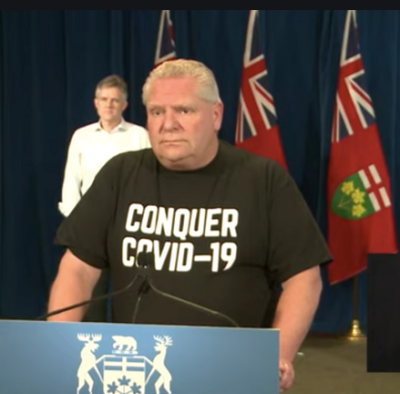 Difficult to say that we are actually conquering the virus. Ford and the Conservatives have been consistent in opposing any implementation of paid sick days with their most common excuse being that it would conflict with existing federal programs. However, despite this, paid sick days has been a key recommendation from many groups to fight the COVID pandemic. Ontario’s associate chief medical officer of health, Dr. Barbara Yaffe; The Ontario Medical Association and the Ontario Hospital Association are among those beyond the NDP who have consistently called for this to be a primary measure in Ontario’s fight against COVID, and the lack of its implementation is a key reason Ontario has fallen behind in this fight.
As of April 18, there have been more than 21,000 COVID-19 cases directly attributable to workplace outbreaks according to the Ontario government’s data (Likely source of infection | COVID-19 (coronavirus) in Ontario). That is in addition to the massive but difficult to quantify numbers of people who have been infected with COVID-19 from caretakers or other health employees.
Throughout this pandemic, workers have been going to work sick because they have no other reasonable choice. Until that is stopped, Ontario will still be at risk.
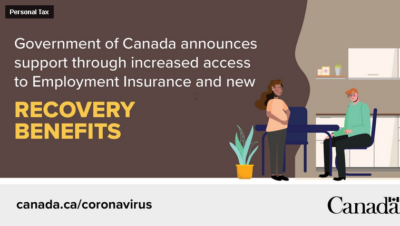 The most common excuse the Ford government has given for why they won’t implement a paid sick leave policy is that is conflicts with the federal government’s Canada Sickness Recovery Benefit (CSRB). Ford has repeatedly referenced this program. “There’s paid sick leave from the federal government,” Ford said on April 7. However, there are many differences between the CSRB and a mandatory sick leave policy and showing the details of the limitations of CSRB, helps to understand why it hasn’t been enough to slow workplace outbreaks. The most common excuse the Ford government has given for why they won’t implement a paid sick leave policy is that is conflicts with the federal government’s Canada Sickness Recovery Benefit (CSRB). Ford has repeatedly referenced this program. “There’s paid sick leave from the federal government,” Ford said on April 7. However, there are many differences between the CSRB and a mandatory sick leave policy and showing the details of the limitations of CSRB, helps to understand why it hasn’t been enough to slow workplace outbreaks.
The first major limitation with CSRB is that it is only paid out if a person actually has COVID or is isolating because a close contact does. You do not get any payments if you were sick for any other reason. So, if you have a cough and are having trouble breathing, you need to get a COVID test. However, you also must still go to work in the meantime, and you are not eligible for CSRB unless that test comes back positive. This obviously doesn’t help people stay home the first day they are symptomatic, which will also be the time where they are most likely to communicate it to others. This limitation alone makes it unlikely that CSRB is doing anything to reduce the spread of COVID in Ontario.
The second major limitation is that CSRB doesn’t provide any job protection. If you are a worker in a factory or warehouse and you catch COVID, CSRB will give you 2 weeks of income. However, your employer can still fire you for not showing up to work. For anyone whose employment is precarious, this is an obvious dealbreaker. It doesn’t matter if that worker gets 2 weeks pay, they are still without a job in an economy that isn’t doing well. If a worker must choose between trying to hide their illness or losing their job, many will choose to try and save their job. In some of those cases, it leads the rest of the workplace to get sick.
The third limitation of CSRB is the logistics of receiving the credit. There are two major technical limitations. First, the benefit only pays out in full weeks. You cannot get the benefit for any part of a week (since all COVID cases would require multiple full week’s isolation). Secondly, a worker won’t receive any money until 4 weeks after they have applied as the government processes the claim. This means that anyone living paycheque to paycheque will have no ability to get the money they need for rent or food because their income would be delayed for 4 weeks. Another reason that precariously employed workers can’t take time off and depend on this program.
Ontario at one time was a province that had mandated sick leave for all workers. It was only 2 days per year, but it offered some protection. However, Ford’s government removed those days in 2018 when they took office. Since that time, the pandemic has made clear what a disastrous mistake that was. Hopefully with all the public pressure being put on the government by Andrea Horwath, the NDP, and various community and medical groups, Ford will relent to the expert’s advice and bring in a long overdue program to ensure that we reduce the number of workplace outbreaks in the future.
Andrew Drummond was the NDP candidate in the last provincial election.

 By Pepper Parr By Pepper Parr
April 19th, 2021
BURLINGTON, ON
There are a lot of people very unhappy with the Premier.
 Dr. Adelstein Brown, Chair of the Science Table , keeps a safe distance from Dr. David Williams, Chief Medical Officer of Health. Members of the Science table who advise the Chief Medical Officer of the province who then advises the Premier are talking about resigning.
They don’t think the Premier understands the gravity of the Covid19 situation and how close we are to being out of control.
Leader of the provincial Liberals want the Premier to resign – Stephen Del Duca said: ““Doug Ford is the worst Premier in Ontario history at a time when leadership matters the most. He should resign now before he makes things any worse. If he does, I will be the first to commend him, because it takes real guts to get out of the way when he’s screwed up this badly. But he won’t. Because he only cares about himself and his special friends.”
That’s just politics – Del Duca has yet to win a seat to even sit in the Legislature.k
It is becoming very clear that this government cannot seem to get ahead of the crisis. Paid sick leave for those people who have the crummy jobs, live with large families, often in congested space, work for a bit more than the minimum wage and having to use public transit doesn’t seem to be something the province is prepared to do.
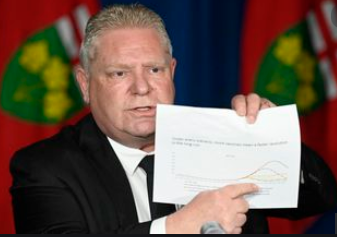 Premier Ford uses data provided by the Science Table as a prop during a media event – but doesn’t follow the recommendations that came with the data. Money can’t be the issue – the Premier keeps saying “whatever it takes”. It takes taking care of the people who work in the hospitals who are approaching burn out, the single parent who works in the supermarket and now has to figure out how she is going to care for her children with schools closed.
The decision to give police the authority to stop people at random and have them justify why they are out of their homes was a stretch when the public was informed – then at least 30 police forces in the province declare they aren’t going to use the authority – the province backs off.
There is a health crisis that is barely under control.
There is a confidence problem as well.

 By Ray Rivers By Ray Rivers
April 18th, 2021
BURLINGTON, ON
OPINION
When you are wrong, you are wrong. The adult thing to do is to just admit it. The debate on carbon taxation is over and Mr. O’Toole has his job cut out educating those dinosaurs in his party who couldn’t even concede that climate change is real.
 With O’Toole’s ‘green’ rewards, the more often you fill up your car the more more points you earn. Everyone had been expecting to see his long promised Tory environment policy, ‘Secure the Environment’. But no one expected O’Toole to include a carbon tax, after all the criticism he had heaped on that idea.
Perhaps that is why O’Toole’s tax actually resembles a loyalty card, a kind of Petro-Point collector. Though since it is mandatory, it’s still a tax, something he doesn’t get. And he clearly also doesn’t understand that the incentive should be to reduce green house gas emissions. With O’Toole’s ‘green’ rewards, the more often you fill up your car the more more points you earn. And those points in your personal low carbon saving account entitle you to a ‘green’ prize of the government’s choosing – rather than a guaranteed fixed rebate on your taxes each year.
Some environmental groups have lauded O’Toole though they note that the bar for him to jump was pretty low. And this may all seem like heady stuff for the Tories, but his environmental plan reads like something the Liberals might have written a couple of decades ago – before we all wasted so much time talking about climate change instead of doing something about it.
Setting a goal of 30% for electric vehicles (EV) sales by 2030, may sound new age, but 30% pales when compared to Quebec’s decision to ban all gasoline car sales by 2035. And the Tory policy document offers no real plan on how to get there.
For a party which sells itself as a tax fighter and calls out its opponents as big taxers and spenders, fiscal conservatives will be holding their noses on election day. There are new taxes proposed for luxury vehicles, frequent flyers and even second homes, in addition to the new carbon tax. It is no wonder that the folks at the Taxpayers Federation are going ballistic, calling O’Toole out for breaking his promises.
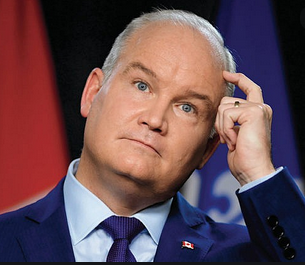 Another billion for car battery development, another billion for hydrogen power from natural gas and five more billion for carbon capture and sequestration And there are billions of dollars in new spending thrown in, as if the traditional Tory pre-occupation with debt no longer matters. There is a billion promised to develop mini nuclear power plants, another billion for car battery development, another billion for hydrogen power from natural gas and five more billion for carbon capture and sequestration – which involves pumping oil sands emissions into the ground and praying they will stay there.
O’Toole has borrowed from Andrew Scheer’s environment playbook, promising more natural gas exports to other countries to help them reduce their coal burning, whether they want it or not. And that probably would lead to more discussion of new pipelines. Interestingly he has backtracked on his party’s opposition to the Liberal’s low carbon fuel standard much as he has now accepted federal carbon pricing for industrial polluters.
There is a brief mention of ‘carbon border trade tariffs’ to level the field for Canadian companies competing against producers in other countries with less constraining environmental standards. This is something the Biden administration is also considering, though it’s an uphill battle against the free trade lobby. Still O’Toole is only committing to study the idea.
While O’Toole talks about increased energy supply he ignores the lowest cost option, the lowest hanging fruit – renewable energy. The Biden administration, south of the border, is banking on wind and solar to drastically shave US carbon emissions. Driving electric or hydrogen powered vehicles will not get Canada to its carbon goals if the electricity that charges/powers them comes largely from carbon based fuels.
 O’Toole’s proposed carbon tax is seriously flawed and may actually lead to increased carbon emissions, rather than reduce them O’Toole understands that the party he leads is out of step with the majority of Canadians, even in Alberta, who expect the country to deal with its pollution and meet its international climate goals. ‘Secure the Environment’ was intended to correct that imbalance. Unfortunately the plan is still too ideologically driven and still too overly consumed with a dying resource sector.
O’Toole’s proposed carbon tax is seriously flawed and may actually lead to increased carbon emissions, rather than reduce them. Further, his decision to introduce his own carbon tax and claim that it isn’t a tax, is shameful behaviour for someone aspiring to Canada’s highest office.
Why not just admit he’s changed his mind and now accepts the existing carbon tax framework, much like he has done for the industrial polluters. And why not confirm the reality that the carbon tax has neither proven a drag on the economy, nor overly hurt working Canadians. Otherwise he wouldn’t be promoting carbon taxation, even if by another name.
 Ray Rivers writes weekly on both federal and provincial politics, applying his more than 25 years as a federal bureaucrat to his thinking. Rivers was a candidate for provincial office in Burlington where he ran against Cam Jackson in 1995, the year Mike Harris and the Common Sense Revolution swept the province. Ray Rivers writes weekly on both federal and provincial politics, applying his more than 25 years as a federal bureaucrat to his thinking. Rivers was a candidate for provincial office in Burlington where he ran against Cam Jackson in 1995, the year Mike Harris and the Common Sense Revolution swept the province.
Background links:
Secure the Environment – Loyalty Cards – Worst of Both –

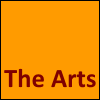 By Tammy Fox By Tammy Fox
April 16th, 2021
BURLINGTON, ON
I find it beyond belief that we have been existing in this Twilight Zone of a pandemic for over an entire year now. COVID has, and continues to have, absolutely devastating effects on everyone – personally, professionally, economically, socially – you name it.
 Tammy Fox, Executive Director, Burlington Performing Arts Centre We invested a great deal of time, effort and funds in developing a sold COVID-safety plan for BPAC last summer so that by early fall we would be in a position to welcome back reduced-capacity audiences in the safest way possible. We increased our air filtration, purchased plexiglass screens and every type of PPE available.
We invested in a socially-distanced ticketing system and seating plans, as well as patron self-screening software. We thoroughly sanitize the venue at least three times daily. When we were finally permitted live audiences of up to 50 people for October and November we scrambled to put together an exciting ‘mini-season’ of incredible artists, like Tom Cochrane, Chantal Kreviazuk, The Spoons and more.
We sold out every performance and I watched as my technical staff’s eyes welled up with tears on our ‘opening night’, overcome with emotion at having the opportunity to finally return after 6 months of suspended operation to what it is that we all do best. To the industry that we love. And then just like that we were slammed back into the ‘red zone’ and the stage lights went dim once again.
Now we are once again in lockdown. We are struggling to understand why we are not permitted to support our community and the Canadian arts ecology when we all need it most, by at the very least offering livestream performances. A typical livestream production might involve 5 – 10 people, between staff and artists, carefully and safely socially distanced in our incredibly spacious venue – but no, the province has deemed that too risky.
Film shoots involving 100 cast and crew are ok. For a long while, allowing hundreds to cram into malls and big box stores was ok. But no livestreaming allowed! Once simply can’t help but feel that the notion of the arts being somehow superfluous, non-essential to the health and spirit of a community is now up in lights on the marquee for all to see. It’s a very scary time for our industry, which has been deemed ‘the hardest hit’. Our industry will be the very last permitted to return to full operations. Ours will take the longest to fully recover.
With that said, there is an incredible amount of heart and effort going into advocacy efforts for the live entertainment sector. Federal agencies are doing what they can to keep us sustainable until life can return to ‘normal’. I do believe that people are eager to return. I feel that people are now truly becoming aware of the cavernous gap left in our lives and in our communities when the performing arts go dark. You don’t know what you’ve got until it’s gone – but absence will make the heart grow fonder!
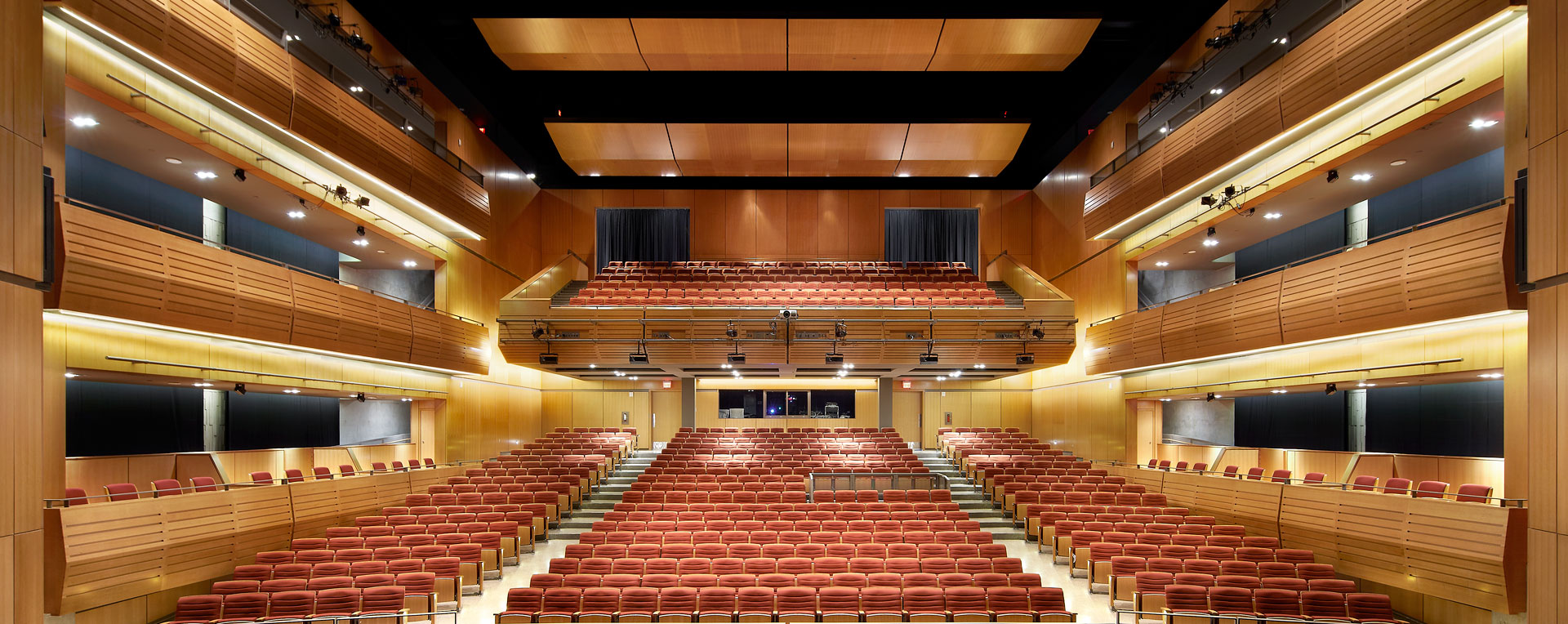 There will come a day when there will once again be a full house At present, I think that the best that we can hope for is offer a series of performances outdoors on our Plaza this summer. I hope to see us being permitted to operate at a percentage of capacity by the fall. At some point someone has to do the math and see that 250 patrons spread out across a 718-seat venue is safer than 50 people crammed into a Walmart check-out line.
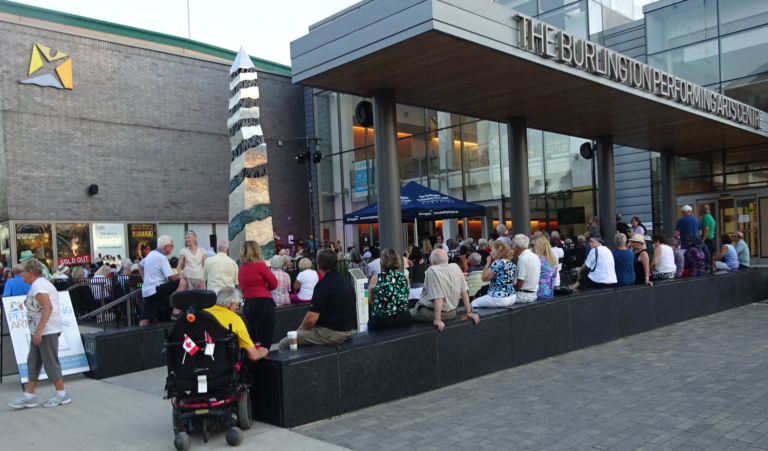 An outdoor performance on the plaza where the best seats were on a marble bench. In the meantime, we are constantly trying to find ways to support our staff, our patrons and our local artists and arts organizations and to keep our volunteers informed and engaged. We have been working with the HDSB by offering students a virtual education series, and we are developing an artist residency program that will see us offering our space and services to local artists. And mostly, we are working towards remaining optimistic and keeping the faith that we will hear that applause again one day soon. It will happen.
Because the show must go on!
Tammy Fox is the Executive Director of the Burlington Performing Arts Centre

 By Lana Parker By Lana Parker
April 16, 2021
BURLINGTON, ON
Despite the lack of data documenting benefits to children, and emerging evidence of several drawbacks and harms, the Ontario government is discussing making full-time online schooling a permanent “choice” in public education.
This idea is being introduced without adequate research, and stands to become the latest measure that raises inequality and threatens the viability of education as a public good.
The Globe and Mail obtained an Ontario Ministry of Education presentation dated March 22, 2021, detailing the prospect of continued virtual learning after the COVID-19 pandemic. The province aims to partner with TVO to offer “fully independent online learning” for “Ontario and out-of-province secondary students” and also mentions continuing “synchronous remote learning” for elementary students.
The proposal coincides with apparent plans to continue to help fund Ontario education by selling curriculum abroad. In 2015, Ontario reported it had agreements with 19 international private schools that pay the province to deliver the Ontario curriculum.
Unpacking the known harms
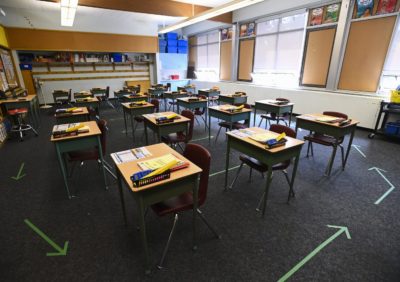 While the COVID-19 environment has produced unique challenges, many of the greatest difficulties for young people have been associated with the forced shift out of schools and into online learning. Online learning does not replace the complex, relationship-oriented learning and social environment in schools. While the COVID-19 environment has produced unique challenges, many of the greatest difficulties for young people have been associated with the forced shift out of schools and into online learning. Online learning does not replace the complex, relationship-oriented learning and social environment in schools.
Fully online learning has had consequences for mental health, with increased feelings of social isolation. There have also been challenges to physical health, as youth grappled with a lack of physical activity and deteriorating eyesight. Even among older youth learners, motivation and engagement prove difficult to sustain online, with a higher potential for dropping out and worse outcomes for disadvantaged students.
Despite the negative outcomes associated with full-time online study for youth and without sufficient data to support its rationale, the Ontario government is introducing an unasked for “choice” that would set a detrimental precedent for public education.
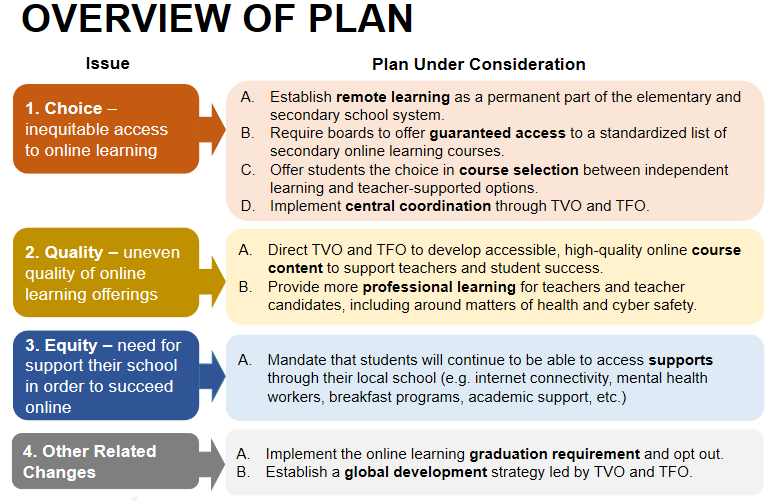
More screen time?
Some might argue that getting students comfortable with online technologies prepares them for future study and the workforce. In my research on youth literacy and online engagement, however, I explore how student proficiency in navigating technology should not be mistaken for understanding complex information.
 My work is part of a wider body of emerging research that examines how students make sense of the online environment — and how being online affects their literacy skills, including their capacities to form critical questions and navigate misinformation and disinformation. My work is part of a wider body of emerging research that examines how students make sense of the online environment — and how being online affects their literacy skills, including their capacities to form critical questions and navigate misinformation and disinformation.
I have also determined that literacy learning can be strengthened when students and teachers explore the emotional implications of contentious issues in a classroom community. In other words, leaving students alone in front of screens for even more of their already online-immersed day does not improve their critical thinking or engagement.
 For adolescents, learning online doesn’t replace in-person interactions with teachers, other students and community members. These interactions, far from superficial or inconsequential, are at the heart of how students learn well. In the pandemic, many teachers have voiced concerns about how an online environment hampers their ability to tailor learning and to support their students with the full range of strategies that are available in the classroom. For adolescents, learning online doesn’t replace in-person interactions with teachers, other students and community members. These interactions, far from superficial or inconsequential, are at the heart of how students learn well. In the pandemic, many teachers have voiced concerns about how an online environment hampers their ability to tailor learning and to support their students with the full range of strategies that are available in the classroom.
Yet another worrying aspect is the risk to student privacy. There is ongoing concern about how tech companies may be gaining unprecedented insight into children’s lives and how data may be used.
There are also issues of tech monopolies that muddy the line between public education and private enterprise.
Generating revenue
Students have opportunities to engage with online learning in Ontario’s current framework. There is no need to introduce compulsory online courses or the option of full-time online learning.
With all the issues implied by full-time online learning, why would Ontario consider making this a permanent feature of public education? Before the pandemic, in February 2020, the government .
In a confidential Ontario government document written sometime between March and August 2019 and obtained by the Toronto Star, the current Ford government detailed a plan to dovetail cuts to school board funding with the opportunity to “to develop (a) business model to make available and market Ontario’s online learning system to out-of-province and international students.” It is telling that the document did not foreground the benefits of full-time online learning for students.
The reasons for this shift can be attributed to the ongoing drive to privatize public education through the twin aims of reducing costs and generating new revenue. The 2019 document also mentioned examining “feasible options for selling licensing rights to courses/content to other jurisdictions.”
Curriculum sales
The current discussions should be seen in the context of Ontario’s drive to create revenue streams through international student tuition and sales of curriculum to international schools.
Ontario’s March 22 proposal for online schooling describes a plan to develop curriculum and offer an education with little teacher support.
This “business plan” follows Minister of Education Stephen Lecce announcing the appointment of a former CFL commisioner to the role of TVO’s CEO. TVO’s website has been recently retooled to include an emphasis on “digital learning.”
Potential future harms
For children, fully online learning creates the conditions for further educational inequality. It is a particular risk for children with special education needs.
It can also produce unintended consequences: a recent study based in Ecuador showed female students working online were more likely to spend time doing housework than their male counterparts. It is not unimaginable that some families could select online schooling for their children so they could help with household work, care for family members and potentially supplement family income by entering the labour market earlier. The move also risks limiting opportunities for extra-curricular socialization and learning, including experiences with the arts and sports.
Once poorly researched educational policy comes into practice, it is difficult to undo irrespective of data that details its harms. Such has been the case with the introduction of standardized testing in Ontario, which marginalizes newcomers and students with exceptionalities, and encourages a narrow curriculum.
Over time, a policy of “choice” for full-time online schooling weakens public education by diluting in-person opportunities for students and eroding funding. An impoverished public system drives families into private schools, which further erodes the public good. Defunding and marketization will leave public education in a race to the bottom.
Background links:
Expanding student access to on line and remote learning – the provincial government agenda
Toronto reveals secret provincial government report about on-line learning –
Laura Parker is an Assistant Professor, Faculty of Education, University of Windsor

 By Eric Vandewall, President and CEO Joseph Brant Hospital By Eric Vandewall, President and CEO Joseph Brant Hospital
April 15th, 2021
BURLINGTON, ON
A short walk from Joseph Brant Hospital is Spencer Smith Park, a beautiful green space by the waterfront where, in past years, friends and families would gather in large numbers to enjoy the warm weather, music and food festivals and open-air movie nights.
We know how difficult this year has been for everyone – we feel it too. We all want to return to a time when we could enjoy the simple pleasures of pre-pandemic life. But we urge you to be patient, stay home and follow all public health measures. We need your help to avert a crisis.
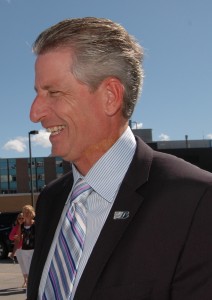 Eric Vandewall Across Ontario, we are seeing enormous strain on our hospitals, and JBH is no exception. The new Variants of Concern have quickly taken hold and are fueling this third wave, causing a rapid surge in cases and hospitalization of patients with more severe symptoms.
At JBH, we are currently at 94% capacity and reached full capacity this past weekend. In just two weeks, the number of COVID-19 patients in our care has more than doubled and continues to increase daily.
We are doing everything we can to make beds available to the rising number of patients – both COVID-19 and non-COVID-19 – who require urgent, life-saving care. We have put all non- urgent surgeries and procedures on hold. We have added four intensive care beds and will be adding three more by the end of this week – 31 beds in total. But resources are limited, and may not be enough if the demand continues.
 Pandemic Response Unit We have been working with our regional and provincial partners in managing COVID-19 care, so that no one hospital is overwhelmed. We have the capability to transition our Pandemic Response Unit – which is currently serving as a Halton Region Vaccination Clinic – back to providing COVID-19 care within 24 hours. We would continue to run the clinic, which has already administered more than 10,000 vaccinations, in another part of the hospital.
Like many of you, our JBH staff and physicians have made enormous sacrifices during the pandemic, and your unwavering support has meant so much. You helped us get through it, and we need your support once again.
Please follow public health guidance. Stay home unless it’s essential, such as buying food or picking up medication. Wear a mask, wash your hands frequently, physically distance from others and do not gather with anyone outside of your household.
There are skeptics who will try to convince you that this is all unnecessary. I can assure you, they are wrong. If this upward trend continues hospitals will be overwhelmed.

 By Julie Hunt Gibbons By Julie Hunt Gibbons
April 15th, 2021
BURLINGTON, ON
Many of the challenges of this pandemic have been solved through the use of technology. The tools of technology have allowed the world of work to continue from a safe distance. Education in Canada has been no different.
Last year’s March – June shut down in elementary, secondary, and post secondary in Ontario was facilitated by the use of online learning, both synchronous and asynchronous, through a host of different learning management systems and educational platforms and applications. This year our provincial public health challenges have varied by population and demographic and we have used technology to respond accordingly.
 Failure to Disrupt: Why Technology Alone Can’t Transform Education Here in Halton, and the surrounding GTHA, students have experienced a variety of synchronous and asynchronous fully online and hybrid learning models in response to the need for student cohorting and swells in Covid-19 numbers. The recent pandemic response, coupled with decades of technological innovation and growing use, have led many people to cite technology as the panacea for educational change in this province and around the globe. They would do well to read Justin Reich’s latest book, Failure to Disrupt: Why Technology Alone Can’t Transform Education” (2020).
Reich does not base his claims on recent pandemic events. In fact, he wrote this book prior to the onslaught of COVID-19 and points out that the supposedly transformative educational technology of the past decade has done little to revolutionize learning. He debunks claims such as:
Harvard Business School’s 2009 claim by Clay Christensen that predicted that half of all American secondary school courses would be online by 2019,
Sal Khan’s claim that Khan Academy videos would reinvent education,
Sebastian Thrun of Udacity’s claim that in 50 years we’d have only 10 institutions of higher education in the world as a result of the success of massive open online courses (MOOCs).
Sugata Mitra’s claim that students no longer need schools or teachers as groups of children with access to the internet could teach themselves anything.
 Computers will be part of classrooms – but they will not replace classroom teachers. Reich addresses MOOCs, autograders, computerized “intelligent tutors,” and widely adopted popular educational software in-depth and traces their hype, their potential,and their ultimate shortcomings. According to Reich, despite their economic success in making their creators wealthy, their benefit has been to primarily wealthy students and they have done little, if anything, to combat growing inequalities in education. Thus this has not been “true innovation” and has not radically changed the educational system in any way. Rather these tools have been adapted, tested, used or not used by educators within the system.
Technology does, and will, continue to play a crucial role in the future of education but as nothing more than a tool for classroom experimentation and the expansion of educators’ pedagogical toolkits.
None of this should come as a surprise; the pandemic has evidenced extreme growth in the use of educational technology, but the key lesson of our online learning experiments in a pandemic have been that there is a want and need for human interaction. Educators have the uniquely human skills to engage (or not engage) students. Education is at its essence a human skill and human pursuit. Change and improvement to education must come from human iterations. There is no magic technological wand.
I join Reich in his confidence that when we take stock of the education our schools provided in our schools during the pandemic, we will see evidence of many new technological classroom and teaching strategies reflective of staff learning and the practicing of technological skills. These are valuable skills and our schools can and should build on them, continuing the process of learning how to teach, learn, and use our digital tools more effectively. Educational improvement is a journey, not a destination and technology can shape and accelerate this journey but technology alone cannot transform education.
 HDSB Superintendent Julie Hunt Gibbons
Julie Hunt Gibbons Halton District School Board Superintendent of Secondary Program & Student Success, North West Oakville Family of Schools was a part of the team that created the iStem courses that began at the Aldershot High school.
Julie was born in Ottawa, graduated from TA Blakelock in Oakville then attended: University of Western Ontario | B.A. Hon. | Sociology and Political Science; University of Windsor | MA. | Sociology (Socio-legal Studies) and University of Toronto |B.Ed. |Intermediate and Senior qualifications
Julie didn’t intend to be a teacher. She did a Masters in Sociology (Socio-legal studies) thinking it would be a good stepping stone to Law School. It was while working as a Teaching Assistant that she fell in love with teaching.

 By Andrew Drummond By Andrew Drummond
April 14th, 2021
BURLINGTON, ON
This past weekend, over 2000 NDP delegates from across the country met at a virtual convention to discuss what direction the party should take moving forward and what policies are important for the NDP to push in the next federal election. The convention was not without its hiccups, and technical difficulties dominated the event in its first 24 hours. Delegates with a disability in particular were frustrated as captioning for the proceedings was not immediately available.
 Jagmeet Singh – a resounding 87% endorsement The most publicly notable part of any political convention in Canada is the vote to endorse the Party Leader. NDPers gave Jagmeet Singh a resounding 87% endorsement which was higher than expectations. Jagmeet also gave a keynote address on the Sunday of the convention where he compellingly argued that without the NDP’s influence the country’s vulnerable would have been for worse off than they were. He quoted a line from a popular meme online: “I’ve heard it said that in this pandemic, we’re all in the same boat. I disagree. We’re not actually in the same boat. We’re certainly in the same storm, but some of us are in leaky lifeboats.” Singh also called out that the Liberal proposal for the CERB program had been $1,000 per month with a 3-month maximum. Only through the pressure tactics of the NDP caucus was the amount and duration increased.
But the core of any convention is the passing of policy the NDP grassroots wants the party to fight the next election on. More than 800 policy resolutions were submitted by riding associations across the country, and delegates prioritized those and then debated over the three days of the convention. The most notable new policies passed are below:
 He’s just an old fashioned millionaire. Make the Wealthy Pay Their Share (80% marginal tax on incomes over $1,000,000)
Delegates in favour of this resolution argued passionately that Canadians earning this amount of income should be more responsible for ensuring a more equitable distribution of wealth across Canada. While exact figures aren’t available, the 99th percentile income in Canada is less than $300,000 per year. The number of Canadians making over $1,000,000 is incredibly small and yet a tax on those individuals would secure considerable funding for programs to help all Canadians.
Re-Establish a federal minimum wage at $20/hour
Delegates on this resolution were focused on the relationship between a minimum wage and a living wage. And after some discussion, delegates were aligned to the idea of $20/hour being necessary because of the incredibly high cost of living in many areas.
Halton was given as an example where the living wage here was $20.38/hour the last time it was calculated in 2019. The wage would only impact federally regulated companies but would hopefully have a significant impact on local economies as well.
Add Long Term Care standards to the Canada Health Act
The experience of Ontario has been noticed by people across the country. Delegates have been outraged at the poor conditions LTC residents have been forced to live in while the private companies managing the sites have been giving out huge dividends to their shareholders. With this policy, the NDP takes a stand that across the country LTC homes will no longer be allowed to be run as for-profit enterprises. It would also enshrine in the Canada Health Act a commitment that any federally funded LTC facility be required to provide a minimum of 4 hours of daily care.
Permanent Paid Sick Days for federally regulated companies
The research in the lead up to this policy shows that 58% of Canadians do not have any paid sick leave. Beyond that, the much touted CRSB program is not suited to day-to-day needs. When a worker starts getting sick, they need that first day off to prevent others from getting infected. The NDP passed a policy demanding 7 permanent sick days per year for all federally regulated companies. It is a very big step towards normalizing paid sick days as required in all businesses.
Canada’s Place in the World
 Refugee camp support has always been a large part of Canadian foreign aid. Historically, the NDP convention has shied away from taking stands on foreign policy. Resolutions calling for international action rarely get prioritized and debated. However, at this convention, the NDP delegates prioritized 2 powerful resolutions calling for action from Canada. First was to unequivocally support farmers in India against the repressive corporate takeover being funded by the Modi government. The second was calling for a boycott of all products made in the Israeli occupied territories as well as an embargo on arms sales to Israel until a fair peace is established with the Palestinian people. This was a landmark policy choice that puts the NDP clearly on the side of those being oppressed and demands Canada take action on the world stage.
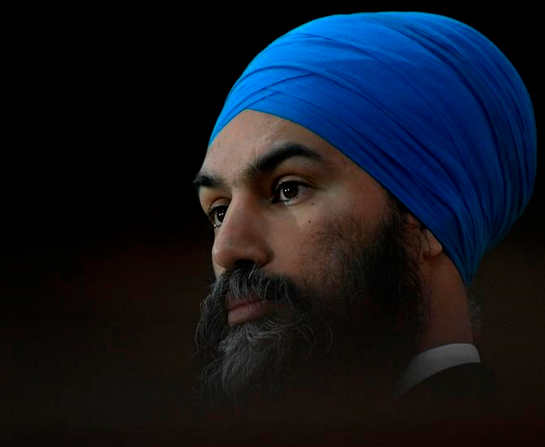 Jagmeet Singh, leader of the New Democratic Party NDP convention 2021 was not perfect. The technical glitches marred what could have been a bigger unifying experience for delegates (Amends were made by refunding delegate fees to all members with a disability). But policies were passed that will drive the NDP platform for the imminent federal election expected later this spring. They are bold, progressive policies that will brand the NDP clearly as the most progressive platform between the major parties. They also give a clear strategy to escaping the economic downturn caused by the pandemic.
The 2021 NDP Convention made clear that the NDP members have a vision for what Canada should be and how it should take care of its people so no one is left behind. Protecting LTC homes, and fighting for a federal minimum wage will make real, material difference in the lives of Canadians. The biggest message from convention 2021 was that the NDP members share a common vision with Jagmeet Singh and are passionate about fighting for that vision in the next election.
Andrew Drummond was the NDP candidate for Burlington in the last provincial election.

 By Ray Rivers By Ray Rivers
April 12th, 2021
BURLINGTON, ON
A record breaking 4000 Canadians participated in the Liberals’ fully virtual 3 day, 60 hour, biennial policy convention this past weekend. And 26 policy resolutions were adopted including; a national pharmacare program, a universal basic income (by a vote of 491-85), and national standards for long term care, as the top three priorities. These now become party policy.
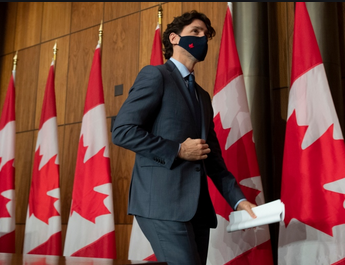 Prime Minister Justin Trudeau Mr. Trudeau delivered a blistering closing address which looked every bit like a pre-election stump speech. Trudeau claims he has no interest in an election at this time. But the polls are good for the Liberals, Canadians are finally seeing vaccines arrive, and the opposition is divided.
Erin O’Toole is battling his own party of climate change deniers, and a-woman’s-right-to-choose is the ghost still haunting the party. Then Mr. O’Toole has some suicidal issues of his own making; namely, bringing back assault weapons and killing the CBC.
The new Green Party leader finds herself in a tussle with the party’s old guard amid accusations of racism. The NDP is struggling to find an issue on which it can out-left the Liberals, and their leader has faded into the background and become the de facto silent partner in the Liberal minority government. And Trudeau must know that every single election during COVID has returned the incumbents, and even propelled a few into a majority position.
Mr. O’Toole is calling for a public inquiry into Canada’s response to the pandemic. That piece of theatre could spell trouble for Mr. Trudeau, given his government’s failings in border control, as recently reported by the Auditor General. Still the Liberals claim they’d welcome such an inquiry. Perhaps they figure it would allow them to focus on the failures of the provinces.
At the outset the provinces rejected Trudeau’s offer of invoking the federal emergency measures act and claimed jurisdiction over administering public health measures to keep the epidemic in check. And they have largely failed, repeatedly, except in Atlantic Canada, allowing this country to recently surpass the US in new COVID infection rates.
Given that most of the provincial premiers are political allies of Mr. O’Toole – one could ask where his voice was in any of this. And in an election Trudeau would claim credit for the economic measures he introduced: workers sick pay, wage subsidies and CERB; which just about everyone supported.
Trudeau has been pretty consistent at following through on his party’s resolutions. Cannabis legalization is a case in point. And he even tried to implement electoral reform before giving up and breaking his promise of change. But he has expressed dislike for the universal basic income policy which almost everyone else in his party wants. So people may be wondering whether Mr. Trudeau is really as liberal as one would expect given his record of financial deficits.
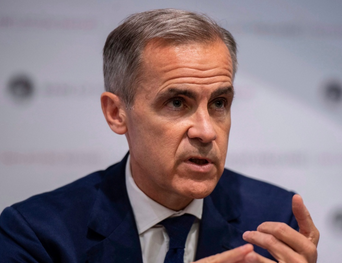 Mark Carney comes out of the closet – he’s a Liberal The keynote address by former Bank of Canada governor Mark Carney got the Liberal chattering class excited. Would he make a suitable replacement for Mr. Trudeau were the Liberals to lose the next election? Carney, who has finally come out of the closet to announce his liberalism, would bring a huge amount of financial credibility to a government now running up massive debt. Perhaps this could be another Paul Martin moment – someone loved by both liberals and fiscal conservatives.
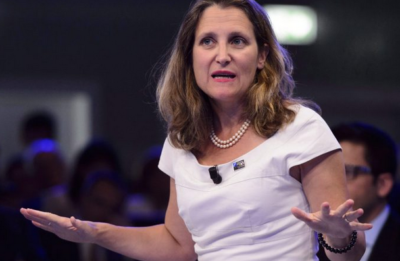 Chrystia Freeland,, Minister of Finance preparing a budget that will set new deficit records ? And speaking of money, Canada’s current finance minister, Chrystia Freeland, talked about a window of political opportunity for her pet initiative, a universal child care program. Among the other resolutions were a couple demanding a Canadian ‘green new deal’ and a post pandemic ‘green’ recovery. And, interestingly, the fourth priority item called for a high speed rail network.
All of these progressive measures will involve some new spending and Canada is already heavily into the red just from all the pandemic security blanket measures. So it was discouraging that relatively pocket-book painless resolutions to increase capital gains taxation and introduce an inheritance tax for estates valued over 2 million were defeated.
Perhaps the delegates think we can grow our way out of debt, or that we should wait for inflation to shrink the relative size of what we owe ourselves.
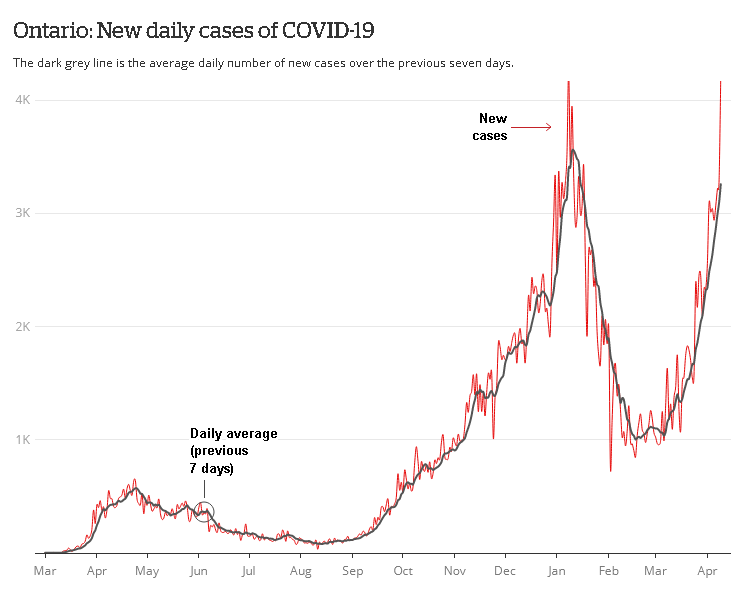
There wasn’t a lot of media coverage of either this event or the NDP convention on the same weekend. The front pages are mostly full of the passing of Prince Philip and the ongoing misery of COVID infections and deaths and the race against time to vaccinate our people. But, whether right or left or in the middle, media coverage of COVID has become more united and has coalesced around a common theme. Our governments have let us all down.
Still 4000 Canadians had enough faith in the future of the Liberal party to make their voices heard at this policy convention, even if it has to be conducted over the internet. And sadly even that number was smaller than the number of people who contracted viral infections in Ontario the day after the convention concluded.
 Ray Rivers writes weekly on both federal and provincial politics, applying his more than 25 years as a federal bureaucrat to his thinking. Rivers was a candidate for provincial office in Burlington where he ran against Cam Jackson in 1995, the year Mike Harris and the Common Sense Revolution swept the province. Ray Rivers writes weekly on both federal and provincial politics, applying his more than 25 years as a federal bureaucrat to his thinking. Rivers was a candidate for provincial office in Burlington where he ran against Cam Jackson in 1995, the year Mike Harris and the Common Sense Revolution swept the province.
Background links:
Liberal Convention – Priority Resolutions – Basic Annual Income –
Green New Deal – Mark Carney Coming Out – Mark Carney –
Our Governments Fail Us – Ontario Failures – Why Does Tam Still –
Lockdowns Meaningless – Public Health Canada Meltdown –

 By Pepper Parr By Pepper Parr
April 10th, 2021
BURLINGTON, ON
OPINION
Is there anyone saying the provincial government is doing a good job in managing the pandemic – the only people who are saying anything positive are the politicians. Their advisors have been pressing for stronger measures to stop the spread of Covid19
Ontario is caught between a rock and a hard place. We don’t have any facilities where we can manufacture the virus and we are having problems getting the vaccines the federal government has ordered.
 Managing the supply of the vaccines under contract isn’t working very well. The federal government has contracts with just about every vaccine company but none of them are delivering on time.
There are delays upon delays. The supply was so short that the rate at which second doses of the vaccines was increased. Difficult to understand how the scientists can invent something and issue instruction saying the product should be applied four weeks apart and then, when the province finds they don’t have enough to deliver on that prescription – they make the second dose months later – and that seems to be OK.
It has to be because the supply just isn’t there.
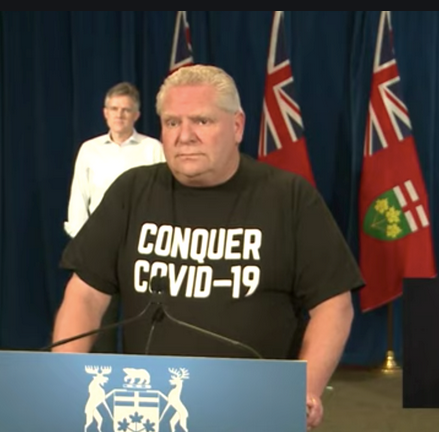 Listening to the advice of people who put the public ahead of politics is proving to be a challenge for the Premier. The politicians are playing political games – Prime Minister says I sent you 2 million doses – and the Premier replies – sure you did – yesterday.
This is beginning to look and sound like a Gilbert and Sullivan comic opera.
We failed the seniors’ community, because the most of the long term care homes are run by the private sector where profits come before service.
We can of course vote the politicians out of office – any assurance that the next lot that get elected will be any better?
The public service is a good place to work. That sector however, seems to have forgotten what serving actually means.
There have been some upsides. The science community has performed, for the most part, superbly. They were able to come up a vaccine in a very short period of time. And the leadership from the science community has pressed the governments to listen.
Finding men and women who bring courage, tenacity and a belief that public service is a calling is the challenge for the rest of us. Hoping for the best isn’t going to be enough.
Salt with Pepper is the musings, reflections and opinions of the publisher of the Burlington Gazette, an online newspaper that was formed in 2010 and is a member of the National Newsmedia Council.

 By Ray Rivers By Ray Rivers
March 30th, 2021
BURLINGTON,, ON
OPINION
Erin O’Toole gave up a huge opportunity to advance the theory that he is a new kind of conservative. He says he wants to move his Conservative Party of Canada (CPC) into the more electable political centre of Canadian politics. That would allow him to challenge the centre-left Liberals for that block of voters who can make the difference between forming government or lingering in opposition.
 Conservative leader Erin O’Toole But then his response following the Supreme Court decision on the constitutionality of federal carbon pricing disappointed a growing number of Canadians who have come to accept the carbon tax as a necessary treatment for our fossil fuel addiction. And it took only a few hours after the court announcement for two of his biggest provincial allies on the tax, Scott Moe and Jason Kenny, to desert him, concluding they would now surrender and likely develop their own provincial carbon taxes.
Ontario has not yet said what it is planning to do, except that it will respect the court decision. Presumably that means doing nothing but watching the feds collect the money and redistribute it as they have been doing. Ford, who came to power after the political assassination of former leader Patrick Brown, killed Brown’s plans for a provincial carbon pricing scheme with great aplomb.
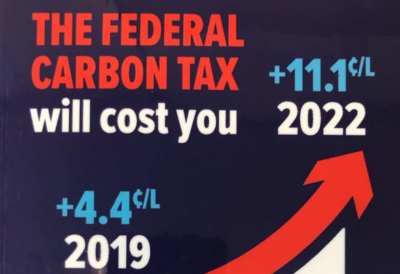 A label that just wouldn’t stay in place. Ford then dismantled the in-place efficient Ontario’s cap and trade carbon pricing system at a cost of at least $5 million . That move is costing the province an additional $2 billion annually in revenues. Then Ford allocated $30 million in his losing effort to fight the federal carbon tax, and spent another $4 million advertising against the tax.
Then there was the cost of producing sticky labels mandated to go on to gas pumps across the province….and promptly fall off again. Fortunately the court decision against the stickies saved Ford, a former label company executive, the embarrassment of presiding over a law and a label that just wouldn’t stay in place. All in all, not bad for a government promising to cut waste.
The Supreme Court ruling has left everyone trying to figure out where O’Toole really stands. On the one hand he has to be admired for entering the lion’s den of his party’s last convention, to declare that climate change is real. Unfortunately the lions disagreed and, behaving like the dinosaurs they are, sent a red-faced O’Toole home, mumbling something about killing the carbon tax anyway.
But the paradox of promising to develop a Trudeau-beating climate plan and promising to kill any kind of carbon pricing scheme at the same time has never dawned on him. He has continued to push the big lie that the tax hurts the poor and the disadvantaged which – thanks to the rebate – it doesn’t. But then why should a little truth get in the way of well-established anti-tax ideology?
He is right, though, that the carbon tax would eventually kill jobs – oil industry jobs in an industry on its way to irrelevance. Recall how politicians in Quebec used to worry about the loss of asbestos industry jobs, even as the workers were dying from asbestosis. That debate ended and despite all the fears, the world did not.
Once all of the provinces introduce their own carbon taxes, the federal tax might almost be moot. Except to be effective a carbon tax has to keep increasing. So that means that the feds will still be setting the rules. And that is why the court decision is so important; to keep carbon pricing advancing and on a level playing field across the country.
It’s clear that O’Toole hasn’t thought this all out. But he is still apparently working on his own climate change plan, which will be handicapped without the incentives offered by higher carbon prices. What might he include then? He could be expected to offer even more subsidies to the oil companies as they try to bury their emissions, something called sequestration. And he might commit to more nuclear power? But don’t expect him to mention carbon pricing.
 Emissions: They are killing the planet Quebec recently committed to ban the sale of gasoline powered cars by 2035. Mr. O’Toole could hitch onto that as a national policy. There is also speculation that the USA under the Biden administration may be looking at a gas guzzler ban as well. Banning the sale of appliances which use fossil fuels, like gas water heaters, would be an even more effective way of curbing the demand for carbon based fuels. Though one can only imagine how those dinosaurs that compose O’Toole’s base would react to that idea.
But no matter what final policy package Mr. O’Toole selects as his plan, to be effective it will have to involve the eventual closure of much of Canada’s fossil fuel industry. And those jobs and all that oil income for the western provinces, where his political power lies, is why he rejected the carbon tax in the first place.
 Ray Rivers writes weekly on both federal and provincial politics, applying his more than 25 years as a federal bureaucrat to his thinking. Rivers was a candidate for provincial office in Burlington where he ran against Cam Jackson in 1995, the year Mike Harris and the Common Sense Revolution swept the province. Ray Rivers writes weekly on both federal and provincial politics, applying his more than 25 years as a federal bureaucrat to his thinking. Rivers was a candidate for provincial office in Burlington where he ran against Cam Jackson in 1995, the year Mike Harris and the Common Sense Revolution swept the province.
Background links
O’Toole on Carbon Taxes – Supreme Court – Conservative Dinosaurs –

 By Pepper Parr By Pepper Parr
March 25th, 2021
BURLINGTON, ON
OPINION
Political leadership is something that has to be grown.
They don’t just fall off a tree like a ripe apple.
Public service is seen as honourable with good salaries and wonderful benefits.
The current city council has a very young group of people. They had an exceptionally steep learning curve and at least two have yet to get to the point where they are competent. They may never get there.
 If Lisa Kearns jumps to Queen’s Park – that opens up the ward 2 seat. The ward 2 council seat is now in play – that will become official when Lisa Kearns comes out of her political closet and confirms that she will carry a Liberal flag come the 2022 provincial election. She will do so when it is to her advantage.
Question then is – who will replace Kearns? Kimberly Calderbank has said she will run again.
Roland Tanner has realized that he would have been a terrible Councillor and has decided to stick to his information technical pursuits. His 905er podcast does not appear to be any better than his description of how he would do as a politician.
The word abstemious might apply.
There is a young man in the city who appears to be grooming himself for a shot at the ward 2 council seat.
David Vandenberg, studied political science at McMaster, served as campaign manager for Rick Goldring in 2018 – that didn’t turn out very well – more the candidate than the campaign manager.
 Name a charity group that needs help – and David Vandenberg will be there. Vandenberg gets involved in organizations focused on helping other people. He is currently part of the Wellington United Church Meals Ministry that prepares take-out meals. It grew out of the Friday Night Community Dinners that were cancelled due to Covid19 issues.
The giveaway sign that David Vandenberg was going to throw his hat into the ring was the Burlington Dave podcast that Vandenberg hosts four times a year.
Vandenberg explains his podcast pursuit this way:
 The Vandenberg score card “Burlington is full of folks of all ages who strive every single day to create a virtuous, equitable and compassionate community. Reflecting on over a decade of local engagement, I have had the privilege of learning about our community, the heroes within it and the landscape in which we live – here in Burlington, Ontario.
“I hope to highlight some of our local heroes, business champions, and heritage and community issues through this blog.
Vandenberg introduces himself to people who visit his Facebook page this way:
“If we have not met before, thanks for popping by! If we know each other, welcome back! My name is David Vandenberg. I am a passionate community leader and speaker in the Halton Region. My deep commitment to innovative community and city-building inspired me to work in the advocacy space for local organizations.
 Vandenberg on a Zoom call “I am a recent McMaster Grad who now works as the Operations Manager of the Meal Bag Program at Wellington Square United Church. Outside of work, I love to capitalize on our proximity to hiking and biking trails, sit on boards of local charities and advocate for issues and people that are close to my heart.
“Building bridges is what I do. I truly believe that when we work together in our community, we can drive a bigger social impact. I hope you enjoy hearing about some of the incredible people, businesses and stories I have to share with you here in Burlington.”
That is about as political as a profile can be.
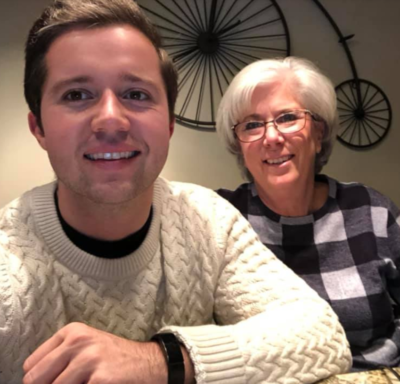 David Vandenberg with his Mother Our first reaction to young Vandenberg is – Good Luck to you, young man. Your heart appears to be in the right place.
And then we ask: Have you ever had a full time job at which you were more than a volunteer. We are aware of some internships you’ve done – all good.
We would like to see situations where you worked hard, got promotions and added responsibility. Were placed in situations where you gained what the soft liberal set call “lived experiences”.
There was a quote you put up on the Facebook that impressed me.

If that is the way you think, if you really have that level if realpolitik you just well might grow into a credible and effective politician.
Goodness know the city could use more of those.
Salt with Pepper is the musings, reflections and opinions of the publisher of the Burlington Gazette, an online newspaper that was formed in 2010 and is a member of the National Newsmedia Council.

“You have a variant (B.1.1.7) that’s 50 per cent more transmissible and you’re using the same tool box and control efforts that barely worked against the previous variant…So of course the prevalence will increase. It might be a bit more or a bit less but if you’re reopening and you have a more transmissible variant, cases will increase. It’s not even really rocket science.” (Chris Bauch, University Research Chair in the Department of Applied Mathematics, University of Waterloo).

By Ray Rivers
March 21st, 2021
BURLINGTON, ON
That vaccines are rolling out across the province is comforting, except that we’ve hardly made a dent in getting to herd immunity. About a million doses have been administered and we need more like 20 times that amount to allow us to get back to some kind of normal. And now we hear that there is a third wave of infections on our doorstep, driven by the variants which are as much as 50% more contagious, demand more hospitalization and are more deadly. So, we are in trouble.
 A field hospital set up by the Army in a parking lot at Sunnybook hospital For over a year now we’ve been in some kind of tiresome on-again-off-again series of restrictions against interpersonal contact. But Ontario’s premier has an itchy trigger finger and can’t break the habit of jumping the gun. He’s done this before. Despite predictions of a second wave last autumn, Ford relaxed public health restrictions resulting in record breaking infection numbers, nearly full hospitals and about 1000 more fatalities. And then Ford refused to re-impose further restrictions until the end of the year, again despite medical advice, and after the virus had firmly embedded itself in our community.
And now, even as Ontario’s COVID-19 Science Advisory Table has told him that we are headed for an ever greater third wave of infections, Mr. Ford is threatening to lessen restrictions on congregate activity rather than tighten them. Having rescinded the stay at home order he has just recently authorized more establishments to reopen. Despite all the impressive compassion he delivers at his media briefings, he clearly doesn’t get it – doesn’t understand the dynamics in play – or it’s all just an act.
 The image on the right is what scientists think the spike portion of a variant virus looks like. Right now we are in the midst of a race between the new virus variants galloping at full speed to infect and kill more people versus protecting enough folks from the virus through vaccination. And the virus is winning. We know this virus continuously mutates, and it’s pure math that the more virus present, the greater the probability of mutation. Just look at the UK, South Africa, Brazil and more recently California. Who knows, there may be an even more powerful variant around the corner?
We have been told that by September everyone in the country should have been administered the vaccine. In as little as six months, then, we might be in a position where the viral contagion no longer will keep our businesses shut and our families and friends distant from their loved ones. It’s a long time but not as long as what the Premier’s failed public health policy has put us through so far. We either choke the virus by locking down or we face the potential consequences of a viral epidemic largely left unchecked.
So Mr. Premier. It’s time to stop gambling with our health and declare a proper lockdown. This province needs a new game plan to check the virus while we get the rest of our population protected with vaccines.
We need a complete province-wide shut down of all congregate activities which are not completely essential, and some kind of compensation for those people whose incomes will be lost in the process. We need another stay at home order and possibly a Quebec styled curfew. We need to close the Ontario border to interprovincial travel, as Manitoba and the Atlantic provinces have done. And we need to keep it that way for at least three weeks, from what the experts are telling us.
It’s not an impossible task. China, where the virus originated, did this last year. The country has had an occasional outbreak since, imported from outside the country, but has been able to trace and isolate all contacts. And life is pretty much back to normal there now. It is the same story with Vietnam, Taiwan, Australia and New Zealand. There are no Chinese or New Zealand variants being created. And their communities have not had to experience second, let alone third waves of infection.
We only need to look at the Atlantic provinces which are Canada’s star performers in fighting the epidemic. History will show that those jurisdictions which dealt effectively with the epidemic have come out of it relatively unscathed. Meanwhile those which failed, like Ontario, have seen their small businesses devastated by the on-again-off-again restrictions; witnessed increases in inequality, mental illness, government debt; and, sadly, unforgivable loss of human lives.
New Zealanders went back to normal last year after only a few weeks in total lockdown. Today, the only way the virus enters there, as it did everywhere else, is by international travel. But even a single new case warrants a total lockdown there, including area roadblocks and severe penalties for those flaunting the rules. Had Mr. Trudeau followed the lead of his friend, Jacinda Ardern, we would have had an effective quarantine system in place over a year ago, holding those foreign variants in check.
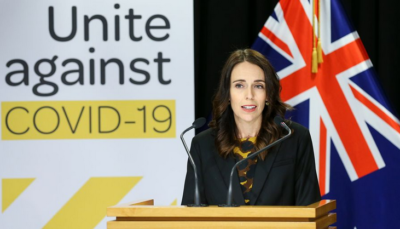 New Zealand Premier Jacinda Ardern, won re-election based on her leadership during the Covid 19 crisis in her country. Will Ontario re-election Doug Ford based on his performance. Prime Minster Ardern is a hero in her country for leading the people in their fight to eliminate the epidemic. She won an overwhelming parliamentary majority in her last election, something rare for any country with a proportional representative electoral system, and the first such win in New Zealand’s history. She is so well regarded that NZ scientists recently named a newly discovered subspecies of the weta, a giant flightless cricket after her – the Hemiandrus jacinda.
We also recently uncovered a new species here in Canada, identified first in the west end of Toronto. It has been tentatively named the the Etobicoke slug. Still, I doubt anyone would suggest renaming it after our premier, despite the sluggish way he has been dealing with the epidemic. And besides wasn’t there a 70’s Canadian pop group with that moniker?
 Ray Rivers writes weekly on both federal and provincial politics, applying his more than 25 years as a federal bureaucrat to his thinking. Rivers was a candidate for provincial office in Burlington where he ran against Cam Jackson in 1995, the year Mike Harris and the Common Sense Revolution swept the province. Ray Rivers writes weekly on both federal and provincial politics, applying his more than 25 years as a federal bureaucrat to his thinking. Rivers was a candidate for provincial office in Burlington where he ran against Cam Jackson in 1995, the year Mike Harris and the Common Sense Revolution swept the province.
Background links”
Third Wave – Variants The COVID Story – Australians – Atlantic Success –
Jacinda – The Etobicoke Slug – Doug and the Slugs –

 By Pepper Parr By Pepper Parr
March 19th, 2021
BURLINGTON, ON
Set out below is a statement the Mayor posted on her Facebook page.
What disturbs me is what a colleague described as “… so much “me too, me too” that it’s embarrassing – like something out of High School.”
 Mayor Marianne Meed Ward Missing is any sense of grace or civility. Mayor Marianne Meed Ward knows that her Council colleague Lisa Kearns earned the identical professional designation but our Mayor was not able to congratulate the ward 2 Councillor for her accomplishment.
Missed was an opportunity to tell people that Burlington is probably the only municipality in Ontario (perhaps the whole country) to have two people on council who have earned the designation and both are female.
What is wrong with this woman – it isn’t just all about her.
Where are her oft used phases: collaboration, working together as part of a team. Meed Ward says frequently that Burlington has a “giddy up” city council.
The statement explains why several of the Councillors don’t want to put up with the way the Mayor interacts with them. Not a good sign as Council moves into the final term of their mandate.
Time for a reset if she expects to get re-elected.
This is such a disappointment after the success of getting a new Official Plan in place and changing where high rise developments will appear.
She can be better than this.


 By Blair Smith By Blair Smith
March 19th, 2021
BURLINGTON, ON
A press release received today from PSD CITYWIDE announced “North America’ Top 20 Open Cities”.
PSD is a corporation with offices in Burlington that serves the municipal sector as consultants, advisors and software providers.
 The organization that gave the city the award published a lot of background material for the municipal sector. Their award sounded like something worth knowing about and certainly something worth celebrating. The ‘presser’ begins with “Today, PSD announces North America’s Most Open Cities with the City of Edmonton, Alberta maintaining their number one spot for the fifth consecutive time. Next, Ottawa, Ontario moves into the second place spot, with Winnipeg, Manitoba coming in third. All top 3 organizations achieved excellent scores and made great strides this year in all three competency categories.” According to the ranking, the City of Burlington is tied with the City of Coral Gables as the 9th Most Open city in North America.
On its face this appears to be a remarkable achievement and one certainly worthy of having a temporary primacy of place on the COB and/or Mayor’s Facebook, Twitter, Instagram and various other social media accounts. However, appearances (and awards) can be deceptive. First, just how many jurisdictions were included in the ‘competition’ and analysis? Remember there are over 400 municipalities in Ontario alone. How many more (or comparable governance bodies) across Canada; how many state and county organizations? The number must be well into the thousands. But, according to the press release, only 41 organizations across North America participated. Is the response then even statistically relevant?
Secondly, to implicitly associate Open Government with the survey’s three evaluation contexts for “open data” is perhaps both misleading and inaccurate.
Open data does not automatically equate with open information and most certainly does not, in itself, constitute open government – not even close. So, the sampling is statistically insignificant, the association perhaps misleading and the ranking virtually meaningless when you consider the sample size. Even so, how did the responding organizations do? How shining is their example? Well, the average score of the 41 was a completely miserable 34.9%. Burlington in the exalted 9th position was barely above 50%.
Really, this is hardly something worthy of a press release; if it does perhaps the banner should read “North America’s Top 20 Most Open Cities Are Still Closed Shops To Their Citizens”.
Blair Smith is a retired provincial civil servant who delegates frequently at city hall and has very strong views on both open data and open, transparent municipal government.

|
|
 By Pepper Parr
By Pepper Parr They didn’t.
They didn’t.



















 Mike Nixon is the Executive Director of Community Development Halton.
Mike Nixon is the Executive Director of Community Development Halton.





 Ray Rivers, born in Ontario earned an economics degree at the University of Western Ontario and a Master’s degree in economics at the University of Ottawa. His 25 year stint with the federal government included time with Environment, Fisheries and Oceans, Agriculture and the Post office. Rivers is active in his community; has run for municipal and provincial office.
Ray Rivers, born in Ontario earned an economics degree at the University of Western Ontario and a Master’s degree in economics at the University of Ottawa. His 25 year stint with the federal government included time with Environment, Fisheries and Oceans, Agriculture and the Post office. Rivers is active in his community; has run for municipal and provincial office.
 The pandemic amplified all the things Canada lauds itself for when it compares itself with the United States – as a nation that is a fraction of the size of the powerhouse next door often does. Its universal health care, a functional government, a communal spirit, and a rule-abiding culture were held up as reasons that case numbers stayed reasonably low. The U.S., meanwhile, bickered about masks and whether the virus was a hoax as cases surpassed anywhere else in the world.
The pandemic amplified all the things Canada lauds itself for when it compares itself with the United States – as a nation that is a fraction of the size of the powerhouse next door often does. Its universal health care, a functional government, a communal spirit, and a rule-abiding culture were held up as reasons that case numbers stayed reasonably low. The U.S., meanwhile, bickered about masks and whether the virus was a hoax as cases surpassed anywhere else in the world.



 The most common excuse the Ford government has given for why they won’t implement a paid sick leave policy is that is conflicts with the federal government’s Canada Sickness Recovery Benefit (CSRB). Ford has repeatedly referenced this program. “There’s paid sick leave from the federal government,” Ford said on April 7. However, there are many differences between the CSRB and a mandatory sick leave policy and showing the details of the limitations of CSRB, helps to understand why it hasn’t been enough to slow workplace outbreaks.
The most common excuse the Ford government has given for why they won’t implement a paid sick leave policy is that is conflicts with the federal government’s Canada Sickness Recovery Benefit (CSRB). Ford has repeatedly referenced this program. “There’s paid sick leave from the federal government,” Ford said on April 7. However, there are many differences between the CSRB and a mandatory sick leave policy and showing the details of the limitations of CSRB, helps to understand why it hasn’t been enough to slow workplace outbreaks.









 While the COVID-19 environment has produced unique challenges, many of the greatest difficulties for young people have been associated with the forced shift out of schools and into online learning. Online learning does not replace the complex, relationship-oriented learning and social environment in schools.
While the COVID-19 environment has produced unique challenges, many of the greatest difficulties for young people have been associated with the forced shift out of schools and into online learning. Online learning does not replace the complex, relationship-oriented learning and social environment in schools.
 My work is part of a wider body of emerging research that examines how students make sense of the online environment — and how being online affects their literacy skills, including their capacities to form critical questions and navigate misinformation and disinformation.
My work is part of a wider body of emerging research that examines how students make sense of the online environment — and how being online affects their literacy skills, including their capacities to form critical questions and navigate misinformation and disinformation. For adolescents, learning online doesn’t replace in-person interactions with teachers, other students and community members. These interactions, far from superficial or inconsequential, are at the heart of how students learn well. In the pandemic, many teachers have voiced concerns about how an online environment hampers their ability to tailor learning and to support their students with the full range of strategies that are available in the classroom.
For adolescents, learning online doesn’t replace in-person interactions with teachers, other students and community members. These interactions, far from superficial or inconsequential, are at the heart of how students learn well. In the pandemic, many teachers have voiced concerns about how an online environment hampers their ability to tailor learning and to support their students with the full range of strategies that are available in the classroom.

































